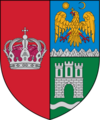Codlea | |
|---|---|
The city centre of Codlea along with the local Transylvanian Saxon fortified church Orthodox church with cemetery Fortified evangelical church | |
 Location in Brașov County | |
| Coordinates: 45°41′49″N 25°26′38″E / 45.69694°N 25.44389°E | |
| Country | Romania |
| County | Brașov |
| Government | |
| • Mayor (2020–2024) | Paul-Mihai Cîmpeanu[1] (PSD) |
| Area | 132.79 km2 (51.27 sq mi) |
| Elevation | 561 m (1,841 ft) |
| Population (2021-12-01)[2] | 20,534 |
| • Density | 150/km2 (400/sq mi) |
| Time zone | EET/EEST (UTC+2/+3) |
| Postal code | 505100 |
| Area code | (+40) 02 68 |
| Vehicle reg. | BV |
| Website | www |
Codlea (Romanian pronunciation: [ˈkodle̯a]; German: Zeiden; Transylvanian Saxon dialect: Zäöeden; Hungarian: Feketehalom) is a city in Brașov County, Transylvania, Romania.
Name
[edit]The Romanian name "Codlea" could be a derivation from the Latin codella, a diminutive of Latin coda (edge, rearward); or it could be a derivation from the Slavic cotal ("kettle"), as the Măgura Codlei (in this reading: "Kettle Hill") looks like a kettle. In Romanian, măgură means "large hill, mound, forest located on a high place".
The hill also provides the Hungarian name of the city, Feketehegy, "Black Hill".
The German name's origin is unknown, but there is a theory that it was derived from Zeidler,[citation needed] an antiquated word for "beekeeper".[3]
History
[edit]
During the 13th century, the Teutonic Order built a fortress known as Schwarzburg ("black castle") near the "Măgura Codlei". The castle's name was first noted in 1265 and was rebuilt for the last time in 1432 by the craftsmen's guild that worked in the town. The city of Codlea is believed to have been also founded by Germans. The fortified church in the city is the largest in the Burzenland historic region. Codlea was well known for its flowers and was called the city of flowers.
Climate
[edit]Codlea has a warm-summer humid continental climate (Dfb in the Köppen climate classification).
| Climate data for Codlea | |||||||||||||
|---|---|---|---|---|---|---|---|---|---|---|---|---|---|
| Month | Jan | Feb | Mar | Apr | May | Jun | Jul | Aug | Sep | Oct | Nov | Dec | Year |
| Mean daily maximum °C (°F) | 0.6 (33.1) |
2.6 (36.7) |
7.3 (45.1) |
13.3 (55.9) |
18.1 (64.6) |
21.4 (70.5) |
23.2 (73.8) |
23.5 (74.3) |
18.5 (65.3) |
13.3 (55.9) |
8.2 (46.8) |
2.1 (35.8) |
12.7 (54.8) |
| Daily mean °C (°F) | −3.8 (25.2) |
−2 (28) |
2.4 (36.3) |
8.2 (46.8) |
13.3 (55.9) |
16.9 (62.4) |
18.7 (65.7) |
18.7 (65.7) |
13.9 (57.0) |
8.4 (47.1) |
3.8 (38.8) |
−1.9 (28.6) |
8.1 (46.5) |
| Mean daily minimum °C (°F) | −8.1 (17.4) |
−6.6 (20.1) |
−2.5 (27.5) |
2.6 (36.7) |
7.8 (46.0) |
11.8 (53.2) |
13.6 (56.5) |
13.7 (56.7) |
9.3 (48.7) |
4.2 (39.6) |
0.3 (32.5) |
−5.4 (22.3) |
3.4 (38.1) |
| Average precipitation mm (inches) | 45 (1.8) |
42 (1.7) |
56 (2.2) |
73 (2.9) |
95 (3.7) |
100 (3.9) |
95 (3.7) |
78 (3.1) |
61 (2.4) |
53 (2.1) |
47 (1.9) |
49 (1.9) |
794 (31.3) |
| Source: https://en.climate-data.org/europe/romania/brasov/codlea-15683/ | |||||||||||||
Population
[edit]- 1510: 670
- 1814: 3,264
- 1849: 3,764
- 1890: 4,035
- 2,680 Germans (67%)
- 1,211 Romanians (30%)
- 44 Hungarians (1%)
- 100 Jews and others (2%)
- 1930: 5,219
- 3,111 Germans (60%)
- 1,916 Romanians (36%)
- 192 Hungarians (4%)
- 1941: 6,214
- 1966: 13,075
- 1977: 22,744
- 1982: 23,500
- 1992: 24,620
- 2002: 24,286
- 2011: 21,708
- 2021: 20,534
As of the 2011 census, 90.2% of inhabitants were Romanians, 5.6% Roma, 2.8% Hungarians, and 1% Germans. As of 2002, 86.8% were Romanian Orthodox, 3.7% Roman Catholic, 3.1% Pentecostal, 2.2% Christian Evangelical, 1% Evangelical Augustan Confession, and 0.8% Reformed.
Natives
[edit]- Fritz Klein (1888–1945), Nazi SS doctor hanged for war crimes
- Doina Popescu (1938–), volleyball player
- Alexandru Zaharescu (1961–), mathematician
References
[edit]- ^ "Results of the 2020 local elections". Central Electoral Bureau. Retrieved 9 June 2021.
- ^ "Populaţia rezidentă după grupa de vârstă, pe județe și municipii, orașe, comune, la 1 decembrie 2021" (XLS). National Institute of Statistics.
- ^ Zeidler, in Duden Wörterbuch (online). Accessed 24 Oct 2023.
External links
[edit]- Codlea - Official site
- Codlea - www.info-codlea
- (in German) Zeiden - site from Gert Liess
- (in German) www.zeiden.de
- (in German) www.siebenbuerger.de






Well, that’s interesting to know that Psilotum nudum are known as whisk ferns. Psilotum nudum is the commoner species of the two. While the P. flaccidum is a rare species and is found in the tropical islands. Both the species are usually epiphytic in habit and grow upon tree ferns. These species may also be terrestrial and grow in humus or in the crevices of the rocks.
View the detailed Guide of Psilotum nudum: Detailed Study Of Psilotum Nudum (Whisk Fern), Classification, Anatomy, Reproduction